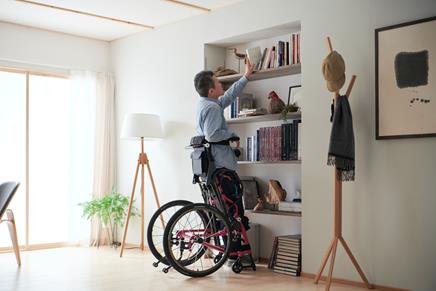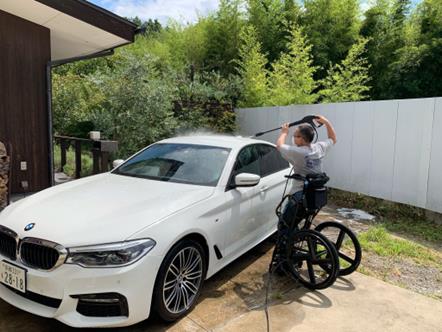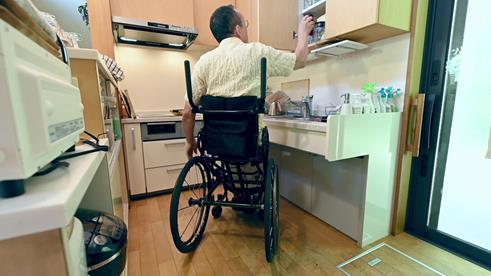NOVA_RiseActive, a standing wheelchair which does not have standing as its goal
Taizo Shibasaki
FORCE Operations Division, Miki Holdings Co., Ltd.
Background to the development
One of our members of staff, who has spinal cord damage, developed pressure sores on his buttocks and was suddenly forced to go into hospital for a long period. He returned to the workplace after this, but because the pressure sores needed care, he ordered a standing wheelchair made overseas and used this during the day to relieve pressure on the affected area as he worked. Now that they have finished healing, this wheelchair has been put away, and he has gone back the manual wheelchair which he had been using. This is despite the fact that even though his sores have healed, he needs to take the pressure off them at regular intervals in order to prevent a recurrence. In other words, for him, the wheelchair was a tool to care for his pressure sores after surgery, not a wheelchair that he wanted to use permanently. So what got in the way of using it on an everyday basis? According to him, he put up with using it because he needed to stand in order to relieve the pressure. A wheelchair is essential for the daily life of a person with spinal cord damage. For this reason alone, there are a range of requirements for a wheelchair for an active user so that it can be used appropriately in various situations in daily life: compact dimensions to turn in tight spaces, high responsiveness, seating functionality that does not tire the user even after a long period, and a secure hold of the trunk. If elements of its role as a wheelchair are below expectations, it will end up as a tool which the user transfers to only when standing. In actual fact, this colleague switched over to the standing wheelchair only when he needed to relieve the pressure. Now that his pressure sores have healed, he has stopped using it.
NOVA_RiseActive was developed from the idea that if a wheelchair which could be used not only as a tool for standing but also in daily life could be commercialized, it would certainly be of benefit to more wheelchair users.
Development concept
This product was designed with a commitment to the following four principles.
1) Compact size
A distinctive feature of wheelchairs for active users is that the user’s legs hang perpendicular to the ground to make the chair compact; furthermore, they are designed to reduce the load on the front wheels and to tilt the pelvis for better controllability. As a result, they are extremely smooth to operate. This product did not compromise on these features, aiming to combine compactness and a standing function.
2) Ease of operation
How far forward the rear axle is positioned is one of the elements which greatly influences the operability of a wheelchair. The rear axle of this product was set close to the user’s centre of gravity (70 mm in front of the surface of the back), a position which makes it easy to turn. On the other hand, the risk of tipping forwards increases, so a fall prevention device has been made optional for users to select according to their degree of skill in handling a wheelchair. In addition, having the rear axle near to the centre of gravity permits a wider range for turning the rims of the wheels by hand, meaning that a single turn of the wheels efficiently drives the wheelchair.
3) Reasonable price
However excellent the functionality, if the price is not set at one which the user can afford, they will not be able to use the product. Since standing wheelchairs are not eligible for payments under the current System for Support with the Cost of Assistive Devices, there are only two options for a user when buying one: receive support for the entire cost as an “exceptional assistive device”, or buy one with their own money. When setting the price, we were not constrained by the prices of existing competitor models, but were driven by our desire for our product to reach as many stakeholders as possible. Whether it is seen as expensive or cheap is up to the customer…
4) Ability to move in any position
Most other standing wheelchairs cannot move in anything other than the driving position, in which the seat is lowered as far as it will go (a stopper comes into operation). I think that this is due to consideration of safety when standing, but like this, it becomes no more than a platform for standing. What we want to supply is a wheelchair which can be moved in the optimum position for each situation in daily life. Able-bodied people squat, sit, or stand according to the contents of each task, but wheelchair users have to carry out almost all tasks in a seated position. We aimed to allow them to carry out tasks in the most suitable posture whenever they needed to and in a natural way.
The efficacy of the active position
This product can be used in three positions, broadly speaking: the “driving position”, “standing position”, and “active position”. When going outside or moving over a long distance, the “driving position”, which permits the most efficient driving, is most appropriate. In the “standing position”, in which the seat is raised to the highest point, the footrest is lowered at the same time that the seat is raised as a measure to prevent the user from tipping forward; and when in the most erect position, the edge of the footrest is in contact with the floor, equipping the wheelchair with a mechanism for preventing falls. In addition, the fact that this standing position is able to support the trunk of a person with bilateral paraplegia with a single belt around the knees is another point to note. Bearing transfers in mind, the knee belt can easily be fastened and released with one hand.
The “active position”, midway between sitting and standing, is this product’s greatest feature. Until now, we wheelchair users have lived our daily lives within the scope of our perspective from a sitting position. Although there have been inconveniences, such as things which we could not reach or see, it cannot be denied that we had partly given up on these things because of our wheelchairs. By changing our perspectives a little in our daily lives, we become able to do the things which we had given up on doing, to see the things which we could not see. This contributes not only to ADL but also to an improvement in QOL, broadening possibilities. Moreover, being in a seated position for a long time leads to health issues such as poor circulation in the lower limbs and compression of the abdominal organs. It is hoped that biological improvements such as lessened pressure on the abdomen and better circulation will also be seen in the active position. A wheelchair which allows you to carry out each task of your daily life from the most appropriate perspective (position): this is NOVA_RiseActive’s true worth.
Customer feedback
Many users have test driven our wheelchair since the prototype stage, and we have asked for their thoughts and impressions. The majority of these have been about the ability to reach objects or carry out tasks up high. Women, in particular, valued “being able to use the top shelf of a large fridge”, “being able to use high-up storage spaces”, “being able to see the contents of pans when cooking”, “being able to take out the laundry easily” – the number of comments related to housework was overwhelming, showing us where they experienced the most problems in their daily lives. There was also feedback which was applicable to hobbies or work, such as “I can now wash the roof of my car myself”, “I tried casting a fishing line”, “I can now play my guitar standing up”, or “I found a way that it might be possible for me to return to work as a hairdresser”. What made me particularly happy out of all this feedback was when a user told me about how they had been able to stand to face their parents at their wedding reception and read them a letter of gratitude. That was a moment in which I was truly glad to have created this wheelchair.
This product tends to be valued for its functionality as a wheelchair which allows the user to stand, but what we would like to offer you is the chance to be set free from having to give up on things which you have been unable to do until now and to broaden your future possibilities even further by using this wheelchair. By changing your perspective a little as you go about your daily life, a wheelchair can make you feel like taking on new challenges – that’s NOVA_RiseActive.
Photo 1 By adopting the standing position, you can retrieve objects from high places

Photo 2 You can also wash the roof of your own car, something which you had given up on doing until now

Photo 3 The active position, in which you can move around as you please, is ideal for kitchen tasks

Edited and published by the Japanese Society for Rehabilitation of Persons with Disabilities.
Published on April 25th, 2023.